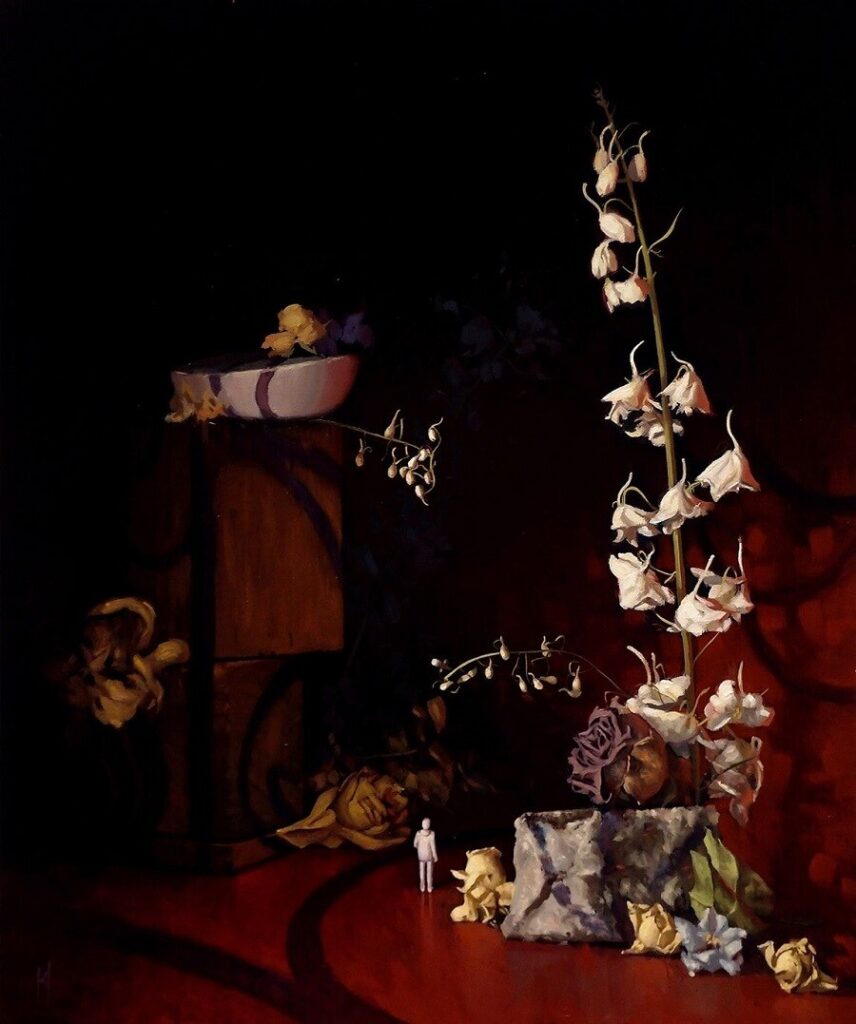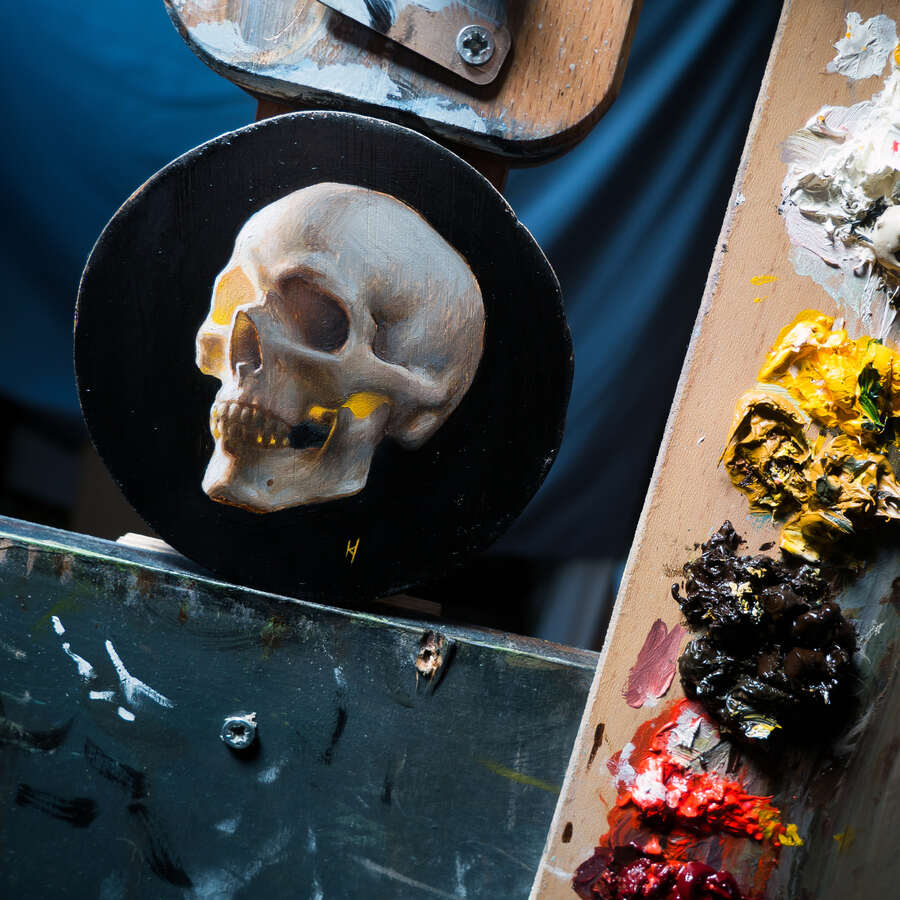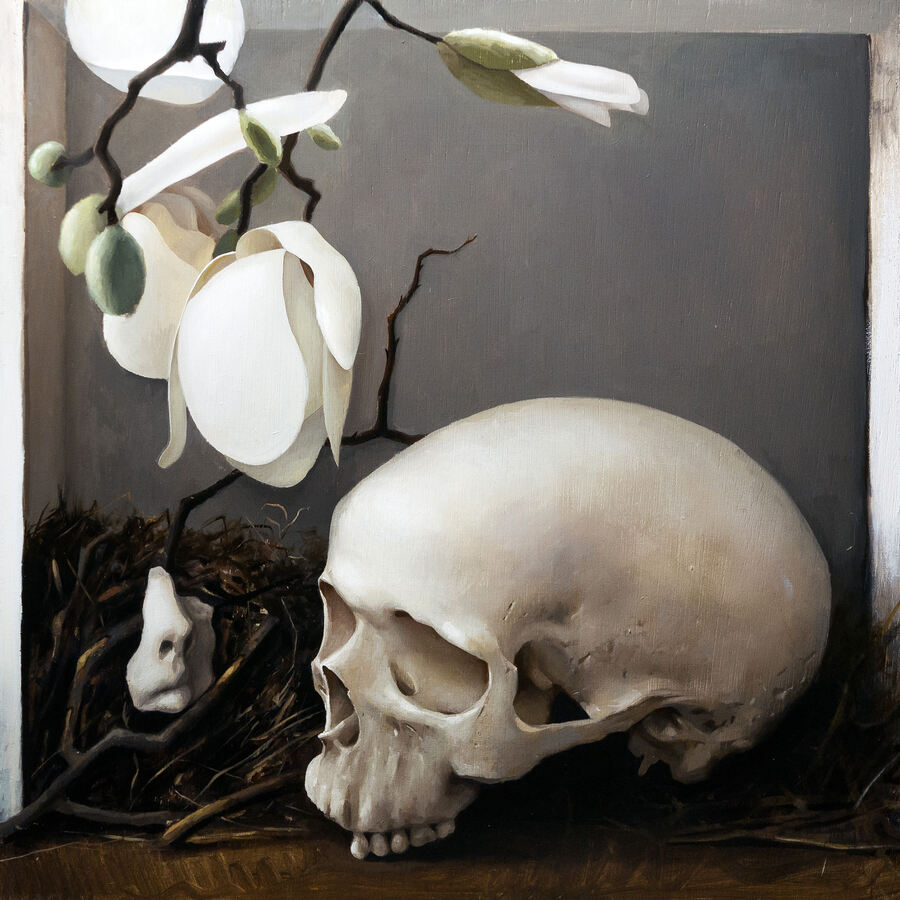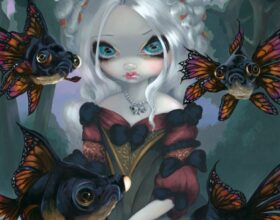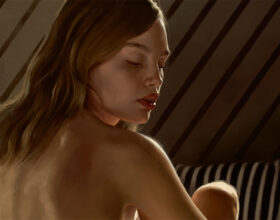If you ever find yourself stopping to admire a still life by Florence-educated, Australian-born painter Kieran Ingram, you may not realize you’ve fallen under the spell of a master illusionist. Like a magician, he asks his audience to question their most basic assumptions about reality. His enigmatic still lifes straddle the line between surrealism and realism, creating scenes cloaked in ambiguity. Painted with hyperrealistic detail and playing with proportion, the interaction between light and darkness, and techniques like trompe l’oeil – ‘to fool the eye’ – his works are simultaneously uncanny and familiar.
“I’ve always found still life really fascinating. I like how it’s a bit of an odd-one-out of subject matter because it’s not as highly regarded traditionally as figurative [painting] and portraiture,” Ingram says, reflecting on his attraction to that medium during our long-distance conversation. He speaks readily on the origins and inspirations behind his work, as fervently introspective as his works are captivating.
Analyzing his work, it’s tempting to attribute individual elements to the influence of the places he’s called home; the Italianate realist technique from Florence where he studied at Angel Academy of Art beginning at the age of seventeen, the romance of the U.K. countryside where, as a child, he visited his Scottish and Northern Irish grandparents, and which he calls home today, or the wild newness of Perth, Australia, where he spent his formative years. But if you ask the artist himself, he’ll tell you that, in reality, what you’re seeing is the very opposite.
The lack of a place is what’s in my work…the way things are incongruous in the still lifes, or surreal would maybe be to do with not feeling strongly linked to a place.
During our interview, he recounts the visceral unevenness of coming of age in a country where his ties to the land felt tenuous. Ingram grew up in Australia, raised by British parents who were in turn brought up in Kenya. As we speak, he recounts the friction of cultural cling-ons from the old world, like receiving a Christmas card depicting a traditional European snowy holiday season while Australia celebrates Christmas during that continent’s high summer heat. “You were born into the landscape, which is not your inherent landscape,” he explains, “And you end up kind of in-between.”
You were born into the landscape, which is not your inherent landscape and you end up kind of in-between.
It’s easy to see that in-betweenness in pieces like Day of the Triffids, in which the figure of a man is dwarfed by an arrangement of wildflowers. As he stands, caught in a moment of hesitation, the viewer is led to wonder, is the man himself small or are the flowers giants? Following the breadcrumbs further into the woods, one might note petals beginning to wilt, the contrast of bright light falling on the figure, and the shadows surrounding him drawing you further into a space between reality and fantasy.
In conversation, it’s clear that every detail of Ingram’s work on canvas is backed by a thought process that is both intuitive and analytical. His practice is as refreshingly bold as the techniques he utilizes are traditional. But the magician’s secret is much less otherworldly than you might guess from looking; the man in the painting is, in fact, a cunningly placed railroad figurine.
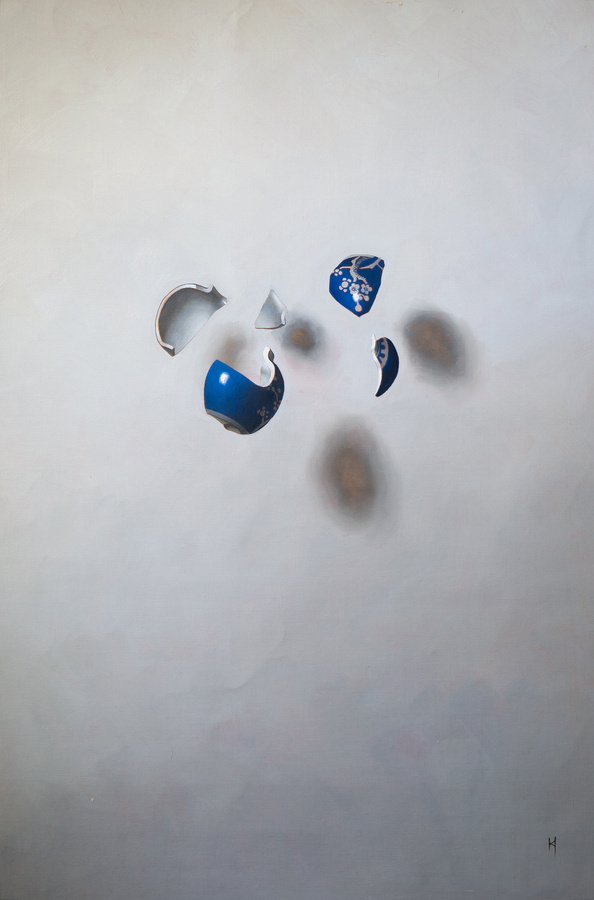

“A proper surrealist like Dalí would create surreal worlds within the painting out of imagination usually, not necessarily drawing on subjects that they’re copying,” explains Ingram, “Whereas my approach is to assemble the objects into a surreal setup so it becomes kind of an assemblage. Pretty much all of the paintings exist in reality somewhere.”
His work draws on his technical training in realism to create a new kind of surrealist narrative. “When people are doing portraiture or abstract portraiture, they’ve still got that focal point of the face that people recognize,” he explains, “But with something like still life, when you’ve got weird objects that you’re trying to hang together, if you start to abstract it, you don’t have anything to hold onto. So, I make the subjects weird and paint them in a conventional way. I play around a lot more with what I paint rather than how I paint it.”
…my approach is to assemble the objects into a surreal setup so it becomes kind of an assemblage. Pretty much all of the paintings exist in reality somewhere.
It’s a bit like dream symbology where one person will dream one thing and another person will dream another thing and it might be the same thing but the symbol shifts based on the dreamer.
Deciphering those playful assortments, like the objects in The Seventh Seal, another of Ingram’s hypnagogic arrangements, might leave you wondering where one finds such an assemblage in reality. The answer, in true Ingram style, is deceptively simple: in a box of collected objects, stored on his studio floor until one day he opened it and saw a painting. (The end result would leave you questioning whether those objects were laying in a box or hovering in another dimension; another signature of his work.)
But most of Kieran Ingram’s still lifes are born from an elaborate system guided by the painter’s own stream-of-consciousness. Made up of objects found and received – he’s a fan of both antique auctions and family heirlooms – each still life is an amalgam of symbols drawn from deep intuition. While sometimes they’re chosen to reflect a certain theme, like a series of floating objects painted in the trompe l’oeil style inspired by T.S. Eliot’s Four Quartets, others are drawn purely from instinct.
“[The objects] become placeholders for things in my mind,” he describes. “It’s a bit like dream symbology where one person will dream one thing and another person will dream another thing and it might be the same thing but the symbol shifts based on the dreamer. When I use objects sometimes they mean different things, sometimes they mean the same thing. In my brain that has a logic, but a lot of it is a bit like dreaming or subconscious creation.”
His relationship to the objects he paints is nebulous – the attraction begins somewhere in the gut, an amorphous feeling of timelessness that makes a typewriter more attractive than a modern keyboard, a history like the one attached to a piece of pottery sunken on a shipwreck and dredged up a hundred years later enticing, fills the eternality of a human skull and its symbolism in our collective psyches with allure. Others have personal significance, like the gold broach depicted in The Seventh Seal – a piece inherited from his grandmother, while others still are found on his wanderings through the woods and pastures near England’s Peak District.
For the past two years, Ingram has taken the pandemic-induced break from traditional gallery exhibitions as an opportunity to focus on another of his still life passions: miniatures. Specifically, memento mori. Crafting miniature skull studies – ones, he notes, that he would have been attracted to as a collector had he seen similar pieces at auction – the miniatures often sell through Instagram before the canvas has even had time to dry.
These memento mori continue a macabre tradition dating back to the stoics of classical antiquity. In visual art, the concept refers to an homage to the inevitability of death with many notable examples coming from 16th and 17th century Holland. With paintings of that period often depicting assemblages of objects like skulls, candles, flowers, and hourglasses symbolizing life, death, time, and impermanence – dubbed Vanitas, a kind of still life symbolic of the transience of life and certainty of death – it’s easy to see why Ingram cites the masters of the Dutch golden age as inspiration for his own work.
For Kieran Ingram, memento mori is also an exploration of the ephemeral symbology of the human skull and its abiding place in our collective consciousness – a dream logic which is universally recognizable across cultures and time. Marrying his interest in memento mori to his ardor for objets d’art, Ingram’s skull studies are often inspired in part by the vintage and antique frames he seeks out to enshroud them. In a tradition dating back to the Pre-Raphaelites, he takes the shape and color of the frame into account when setting up the still life, even allowing the undertones of the frame to dictate the undertones of the final painting, ultimately viewing the frame as a part of the art.

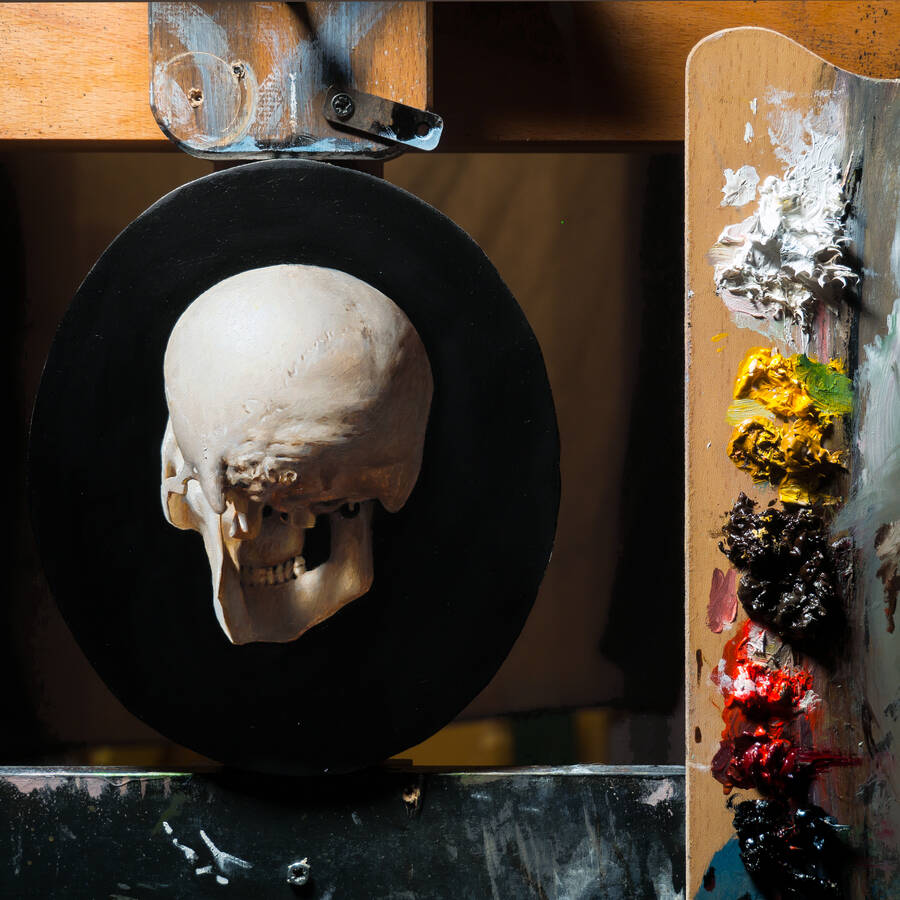
When he’s not working on his own pieces, Ingram teaches the classical techniques he utilizes in his own work through his art school, Scumble & Glaze. With students ranging from professional artists who want to advance their technique to tattoo artists seeking new ways to perfect realism in portraiture, he imparts the same time-honored systems he learned in Florence through small group seminars and one-on-one mentorship.
As the world opens back up for physical exhibitions after two years of closed doors and locked galleries, he’s turning his eye to the pastoral scenes surrounding his home city. He’s long held a vision for placing the objects of his dreamlike nature mortes into landscapes. His fascination for working in miniature has also grown; he hopes to continue exploring objects in their minutest form.
Presently, he’s also intrigued by large scale pen-and-ink drawings, taking the careful strokes of that monochromatic medium and its requisite textures to an overblown scale. Perhaps in the future we’ll have the pleasure of seeing the strangely magnetic incongruity of those miniatures and massive masterpieces displayed together. In the meantime, you can follow Ingram’s work and look out for future gallery showings via his Instagram. I know we will be.





